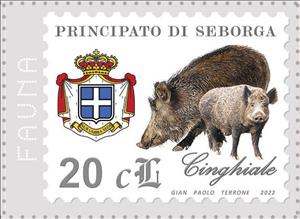Stamp: Boar (Cinderellas 2022)
Boar (Cinderellas 2022)
20 August (Cinderellas ) within release Italy : Principality of Seborga goes into circulation Stamp Boar face value 20 Seborgan cent
| Stamp Boar in catalogues | |
|---|---|
| Colnect codes: | Col: IT-SB 2022-03/6 |
Stamp is square format.
Stamp from mini sheetAlso in the issue Italy : Principality of Seborga:
- Stamp - Bee face value 20;
- Stamp - Black tomato face value 20;
- Stamp - Boar face value 20;
- Stamp - Broom face value 20;
- Stamp - Church of San Bernardo face value 20;
- Stamp - Church of San Martino face value 20;
- Stamp - Coat of arms of the Principality face value 20;
- Stamp - Flag of the Principality face value 20;
- Mini Sheet - Flora, fauna and food S/S face value 9*20;
- Stamp - Guards face value 20;
- Stamp - Knights Templar face value 20;
- Stamp - Knights Templar face value 20;
- Stamp - Luigino coin, 1669 face value 20;
- Stamp - Luigino coin, 2021 face value 20;
- Stamp - Mimosa face value 20;
- Stamp - Nina Menegatto (1978-), Princess of Seborga face value 20;
- Stamp - Nina Menegatto (1978-), Princess of Seborga face value 20;
- Stamp - Olive tree face value 20;
- Stamp - Pastel drawing of Piazza della Libertà face value 20;
- Stamp - Pastel drawing of Piazza della Libertà face value 20;
- Stamp - Pesto face value 20;
- Stamp - Taggiasco oil face value 20;
- Stamp - View of Seborga face value 20;
- Stamp - View of Seborga, Fiat 500 and Princess Nina face value 20;
- Mini Sheet - Views from the Principality of Seborga S/S face value 6*20;
- Mini Sheet - Views from the Principality of Seborga S/S face value 9*20;
- Stamp - Wild rabbit face value 20;
|
Data entry completed
50%
|
|
|---|---|
| Stamp Boar in digits | |
| Country: | Cinderellas |
| Date: | 2022-08-20 |
| Emission: | Cinderella |
| Format: | Stamp |
| Face Value: | 20 Seborgan cent |
Stamp Boar it reflects the thematic directions:
Animals are multicellular, eukaryotic organisms of the kingdom Animalia (also called Metazoa). All animals are motile, meaning they can move spontaneously and independently, at some point in their lives. Their body plan eventually becomes fixed as they develop, although some undergo a process of metamorphosis later on in their lives. All animals are heterotrophs: they must ingest other organisms or their products for sustenance.
A coat of arms is an heraldic visual design on an escutcheon (i.e. shield), surcoat, or tabard. The coat of arms on an escutcheon forms the central element of the full heraldic achievement which in its whole consists of shield, supporters, crest, and motto. A coat of arms is traditionally unique to an individual person, family (except in the United Kingdom), state, organisation or corporation.
In British heraldry, a coronet is any crown whose bearer is less than sovereign or royal in rank, irrespective of the crown's appearance. In other languages, this distinction is not made, and usually the same word for crown is used irrespective of rank (German: Krone, Dutch: Kroon, Swedish: Krona, French: Couronne, etc.) In this use, the English coronet is a purely technical term for all heraldic images of crowns not used by a sovereign, and implies nothing about the actual shape of the crown depicted. A Coronet is another type of crown, but is reserved for the lower ranks of nobility like Marquesses and Marchionesses, Earls and Countesses, Barons and Baronesses, and some Lords and Ladies. The specific design and attributes of the crown or coronet signifies the hierarchy and ranking of its owner.
Mammals are any vertebrates within the class Mammalia (/məˈmeɪli.ə/ from Latin mamma "breast"), a clade of endothermic amniotes distinguished from reptiles (including birds) by the possession of a neocortex (a region of the brain), hair, three middle ear bones and mammary glands. All female mammals nurse their young with milk, secreted from the mammary glands. Mammals include the largest animals on the planet, the great whales. The basic body type is a terrestrial quadruped, but some mammals are adapted for life at sea, in the air, in trees, underground or on two legs. The largest group of mammals, the placentals, have a placenta, which enables the feeding of the fetus during gestation. Mammals range in size from the 30–40 mm (1.2–1.6 in) bumblebee bat to the 30-meter (98 ft) blue whale. With the exception of the five species of monotreme (egg-laying mammals), all modern mammals give birth to live young. Most mammals, including the six most species-rich orders, belong to the placental group. The largest orders are the rodents, bats and Soricomorpha (shrews and allies). The next three biggest orders, depending on the biological classification scheme used, are the Primates (apes and monkeys), the Cetartiodactyla (whales and even-toed ungulates), and the Carnivora (cats, dogs, seals, and allies).




